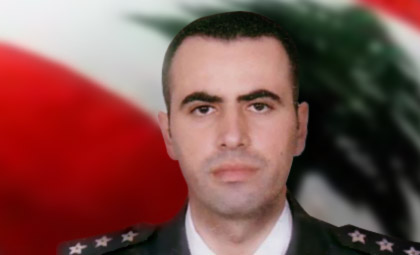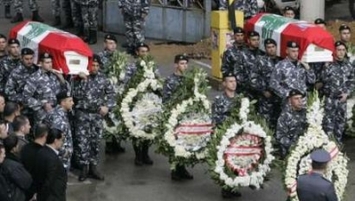Whoever killed former prime. minister Rafik Hariri , killed my son, mother of slain Lebanese Major Wissam Eid said.

In an interview with Al-Hadath, she said: “My son’s investigations confirmed that the car that placed the explosives used in the assassination of Hariri went the Dhahieh ( a Hezbollah suburb south of Beirut) . ” adding “Hezbollah threatened my son twice to stop the investigations of the assassination of Hariri.”
“We lived through a period of terror before the assassination of my son because of Hezbollah’s threats to him,” she added, adding that “Investigative judge Rizk leaked the Hariri assassination investigation to Hezbollah and informed the killer of Hariri of the investigation details .”
She said, “Lebanon has become a colony of Iran and is ruled by Hezbollah,” pointing out that “everything that happens in Lebanon has the approval of Hezbollah or is ordered by Hezbollah.”
Eid’s investigation was the most important evidence used by the Special Tribunal for Lebanon to convict Hezbollah operative Salim Ayyash, in the assassination of Hariri
About Wissam Eid and his investigation
Before his violent death in 2008, Wissam Eid was an unusual figure in the murky, often corrupt world of Arab policing.
He had never actually wanted to be a policeman, or an intelligence officer. In authoritarian Arab society, he had no interest in becoming an authority figure. And yet, he’d had no choice.
When he was doing his military service in the 1990s, the ISF, Lebanon’s all-encompassing security force, noticed Eid’s degree in computer engineering.
The security service was then trying to build an information technology department. And that was that.
“He was a patriot,” says his father Mahmoud, sitting in the living room of the family home in Deir Ammar, on the outskirts of Tripoli.
The centerpiece of the room is, in the Arab way, a shrine to their son. The young man’s intense, chiseled countenance stares back at visitors over commendations and testimonials.
His mother Samira, a picture of Islamic dignity, is a religious person. It helps with the grief.
The rest of her family is not particularly observant. But they all understand the savage realities of their country and how those realities clashed with Eid’s unyielding pursuit of some of the most dangerous people in the world.
By the time Hariri was killed in 2005, Eid was a captain in the ISF. His boss, Lt.-Col. Samer Shehadeh, brought him into the investigation.
It was a Lebanese investigation, Eid was told, but it was also a UN one. Eid was to co-operate with the foreigners working out of the old abandoned hotel in the hills above Beirut.
Process of elimination
Capt. Eid, though, wasn’t interested in delving into some of the wilder theories making the rounds in Lebanon.
He reasoned that finding the first traces of the killers was a process of elimination.
From Lebanon’s phone companies, he obtained the call records of all the cellphones that had registered with the cell towers in the immediate vicinity of the Hotel St. George, where the massive blast had torn a deep crater.
Once Eid had those records, he began thinning out the hundreds of phones in the area that morning, subtracting those held by each of the 22 dead, then those in Hariri’s entourage, then those of people nearby who had been interviewed and had alibis.
Soon enough, he had found the “red” phones the hit team had used.
But he didn’t stop there. Exhaustively tracking which towers the red phones had “shaken hands with” in the days before the assassination, and comparing those records to Hariri’s schedule, he discovered that this network had been shadowing the former PM.
The red-phone carriers were clearly a disciplined group. They communicated with one another and almost never with an outside phone. And directly after the assassination, the red network went dead forever.
But Eid had found another connection. He eventually identified eight other phones that had for months simultaneously used the same cell towers as the red phones.
Signals intelligence professionals call these “co-location” phones.
What Capt. Eid had discovered was that everyone on the hit team had carried a second phone, and that the team members had used their second phones to communicate with a much larger support network that had been in existence for at least a year.
Eventually, the UN would label that group the “blue” network.
More networks
The blue network also exercised considerable discipline. It, too, remained a “closed” network. Not once did any blue-network member make the sort of slip that telecom sleuths look for.
But these people also carried co-location phones and Eid kept following the ever-widening trail of crumbs.
The big break came when the blue network was closed down and the phones were collected by a minor electronics specialist who worked for Hezbollah, Abd al Majid al Ghamloush.
Ghamloush was, in the words of one former UN investigator, “an idiot.”
Given the job of collecting and disposing of the blue phones, he noticed some still had time remaining on them and used one to call his girlfriend, Sawan, in the process basically identifying himself to Capt. Eid. He might as well have written his name on a whiteboard and held it up outside ISF headquarters.
Ghamloush’s stupidity eventually led Eid to a pair of brothers named Hussein and Mouin Khreis, both Hezbollah operatives. One of them had actually been at the site of the blast.
Capt. Eid kept going, identifying more and more phones directly or indirectly associated with the hit team. He found the core of a third network, a longer-term surveillance team that would eventually be dubbed the “yellows.”
Eid’s work would also lead to another discovery: Everything connected, however elliptically, to land lines inside Hezbollah’s Great Prophet Hospital in South Beirut, a sector of the city entirely controlled by the Party of God.
It has long been said that the fundamentalist fighters operate a command centre in the hospital.
Eventually, telecom sleuths would identify another network of four so-called “pink phones” that had been communicating both with the hospital and, indirectly, with the other networks.
These phones turned out to be tremendously important. It turned out they had been issued by the Lebanese government itself and when the ministry of communications was queried about who they had been issued to, the answer came back in the form of a bland government record.
CBC has obtained a copy of this record provided to the commission. On it, someone has highlighted four entries in a long column of six-digit numbers. Beside the highlighted numbers, in Arabic, was the word “Hezbollah.”
Hezbollah has several seats in the Lebanese legislature and at the time had been part of a governing coalition, hence the government-issued phones.
Finally, Eid was handed a clue from the best source possible: He was contacted by Hezbollah itself and told that some of the phones he was chasing were being used by Hezbollah agents conducting a counter-espionage operation against Israel’s Mossad spy agency and that he needed to back off.
The warning could not have been more clear.
As though to underscore it, Eid’s boss, Lt.-Col. Shehadeh, was targeted by bombers in September 2006. The blast killed four of his bodyguards and nearly killed Shehadeh, who was sent to Quebec for medical treatment and resettlement.
By that time, Capt. Eid had sent his report to the UN inquiry and moved on to another operation.
The Eid report was entered into the UN’s database by someone who either didn’t understand it or didn’t care enough to bring it forward. It disappeared.
Mixed with shame
A year and a half later, in December 2007, when the Eid report finally resurfaced, the immediate reaction of the UN telecom team was embarrassment. And then suspicion.
Eid claimed to have performed his analysis using nothing but Excel spreadsheets and that, said the British specialist, was impossible.
No one, he declared, could accomplish such a thing without powerful computer assistance and the requisite training. No amateur, which is how the specialists regarded Eid, could possibly have waded through the millions of possible permutations posed by the phone records and extracted individual networks.
This Capt. Eid must have had help, thought the telecom experts. Someone must have given him this information. Perhaps he was involved somehow?
By now it was January 2008. A new UN commissioner was in charge, a Canadian justice official named Daniel Bellemare. Investigators were finally beginning to believe they were getting somewhere.
A deputation of telecom experts was dispatched to meet Eid. They questioned him and returned convinced that, somehow, he had indeed identified the networks himself.
Eid appeared to be one of those people who could intuit mathematical patterns, the sort who thinks several moves ahead in chess. Even better, he was willing to help directly. He wanted Hariri’s killers to face justice, Hezbollah’s warning be damned.
It was an exciting prospect for the UN team. Here was an actual Lebanese investigator, with insights and contacts the UN foreigners could never match.
A week later, a larger UN team met with Capt. Eid and, again, all went well.
Then, the next day, Jan. 25, 2008, eight days after his first meeting with the UN investigators, Capt. Wissam Eid met precisely the same fate as Hariri. The bomb that ripped apart his four-wheel-drive vehicle also killed his bodyguard and three innocent bystanders.

Lebanon gave Eid a televised funeral and, at the UN inquiry, there was outrage as well. But mixed with shame.
Because there was no doubt in the mind of any member of the telecom team why Eid had died: Hezbollah, they deduced, had found out that Capt. Eid’s report had been discovered, that he’d met with the UN investigators and that he had agreed to work with them.
Immediately, the telecom team had the records of the cell towers near the Eid blast site collected, reasoning the killers might once again have left digital footprints they could follow.
Not this time, though. There was nothing. This time the killers did what they should have been doing all along: They’d used radios, not cellphones. Radios don’t leave a trace.
That left the UN team with the obvious problem. Their adversary obviously knew not only what the UN investigators were doing, but knew in considerable detail.
And the more the UN investigators thought about it, the more they focused on one man: Col. Wissam al Hassan, the new head of Lebanese intelligence.

Leave a Reply
You must be logged in to post a comment.